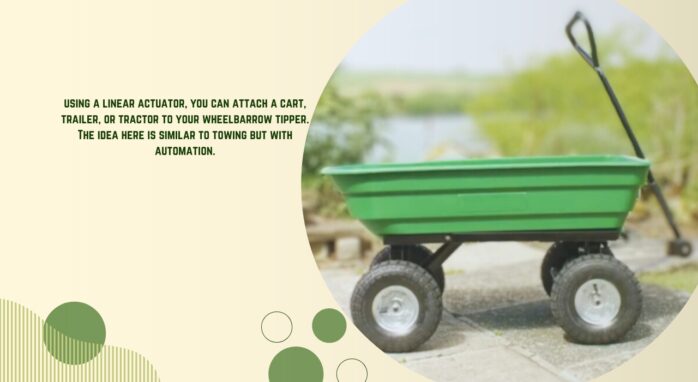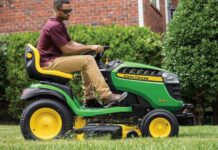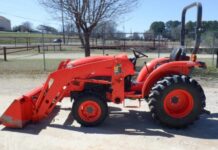
Wheelbarrows have many uses in everyday home use. However, they can sometimes be a headache to handle, especially when dealing with heavy loads. That’s where wheelbarrow tippers have an advantage. They tilt, making it easy to dump what’s in the barrow. However, working is easier if you enhance your wheelbarrow tippers by using a linear actuator.
Particularly, the focus is on an electric linear actuator with a motor powered by a battery. The advantage such a setup brings is that you can skip tilting the wheelbarrow tipper by hand.
Instead, you control the tipper remotely, using a switch, remote control, or sensor, depending on the actuator type. Read on as we discuss more.
WheelBarrow Tipper using A Linear Actuator
Consider a wheelbarrow tipper filled with sand. If it’s a typical dump wagon, you must release the frame lock for the barrow to bend and empty its content. Afterward, you pull the barrow up and attach the lock. It’s not a challenging task, but you can make it simpler with automation.
Linear actuators work for such an automation project. You can check out this to find many ways to use the devices to simplify your home life. The video also illustrates how a wheelbarrow tipper works using a linear actuator. We still explain the working mechanism below.
The Working Mechanism With a Linear Actuator
To start with, note that linear actuators are available in different types. There are tracks, micro, rod, and feedback devices, and any can work depending on your preferences.
For instance, if you want the wheelbarrow tipper to function with a sensor, you need a linear actuator with feedback. Meanwhile, if it’s a small structure, a micro-motion device will work.
Generally, however, we recommend you go for rod linear actuators. These devices are heavy on precision, which is what you want for optimal performance. At the same time, they still have high stroke lengths — up to 60 inches — allowing the barrow to tilt at any angle. Furthermore, rod-style actuators are versatile because you can operate them using a switch, remote, or sensors.
Now, if you have a suitable motion device, the installation is straightforward. You’ll mount the linear actuator on the wheelbarrow tipper’s frame and attach it to the handle. So, when you activate the controller, the actuator will push the handle, adjusting the angle of the barrow.
This happens with a straight, smooth, and precise motion as the rod extends. Conversely, the rod retracts to return the wheelbarrow to its regular position.
You can set the actuator to tilt the barrow at any angle or dump it off the tipper. In addition, the devices have customizable speeds, which you’ll leverage depending on the load.
Another Way to Use Actuators in WheelBarrows
We’ve focused more on using an electric linear actuator to tilt the tipper to dump the content of the wheelbarrow. That’s a significant role of the motion devices in the setup, but it’s not the only way to leverage them. Another workable option is attaching the wheelbarrow tipper to another piece of equipment.
For instance, using a linear actuator, you can attach a cart, trailer, or tractor to your wheelbarrow tipper. The idea here is similar to towing but with automation.
Also, the actuator won’t just move the attachment along with the wheelbarrow tipper. You can connect it such that the attachment tips when tilting the barrow.
To achieve the above, you’ll mount the actuator on the other equipment — trailer, tractor, or cart. Then, you attach it to the handle of the wheelbarrow tipper using brackets. That way, the actuator can move the wheelbarrow with the other equipment.
You can also employ a linear actuator to create a retractable wheelbarrow tipper. Here, you’ll mount the motion device on the tipper’s frame and connect it to the rear of the wheelbarrow.
When you activate the actuator, the rod extends or retracts the wheelbarrow length as intended. Such a structure adjusts the size of the wheelbarrow, allowing you to carry different loads.
Benefits of WheelBarrow Tipper using A Linear Actuator
When you automate your wheelbarrow tipper, there’s much to benefit. The most apparent is that operating the tipper becomes more convenient. You won’t deal with the physical strain and fatigue compared to pushing the barrow manually to offload. To add, you’ll save time.
A wheelbarrow tipper using a linear actuator also fosters efficiency. You can program the motion device to tilt the barrow at the right angle to empty its content. For some load types, this function will help prevent spillage.
Also, since you control the setup remotely, there’s almost zero chance of suffering accidents and injuries should the tipper move the wrong way.
Finally, consider the setup where the linear actuator extends and retracts the barrow. The advantage here is that you get a versatile and flexible tipper that can handle several carrying tasks.
Maximizing Efficiency and Savings
The adoption of linear actuators for automating wheelbarrow tippers is an economically judicious solution with promising long-term returns. The initial expenditure involved in obtaining the actuator and establishing the automation system is compensated by gains in efficiency and user convenience over time.
This mechanization significantly reduces physical strain on users, potentially decreasing healthcare costs linked to work-related injuries.
An increase in productivity due to expedited, accurate unloading of materials can enhance profit margins, especially in sectors such as construction, landscape architecture, horticulture, and agriculture. The adaptability of linear actuators enables customization of the wheelbarrow tipper for varied tasks, eliminating the need for multiple specialized equipments and hence, additional costs.
Therefore, linear actuator integration in wheelbarrow tippers is a strategic investment, optimizing work processes, and promoting efficiency in various applications.
To summarise, the economic viability of integrating linear actuators into wheelbarrow tippers substantiates it as a judicious capital investment. It has the potential to enhance operational protocols and foster superior efficiency across a multitude of applications.
Consequently, the scientific consideration of this automation method is a necessary endeavor for industries invested in streamlining their operational processes.
Conclusion
Save time and energy doing manual work by automating your wheelbarrow tippers using a linear actuator. You can leverage this in many ways, including tipping to dump content, attaching to different equipment, and extending and retracting the wheelbarrow. The best part is that the installation isn’t complex.









